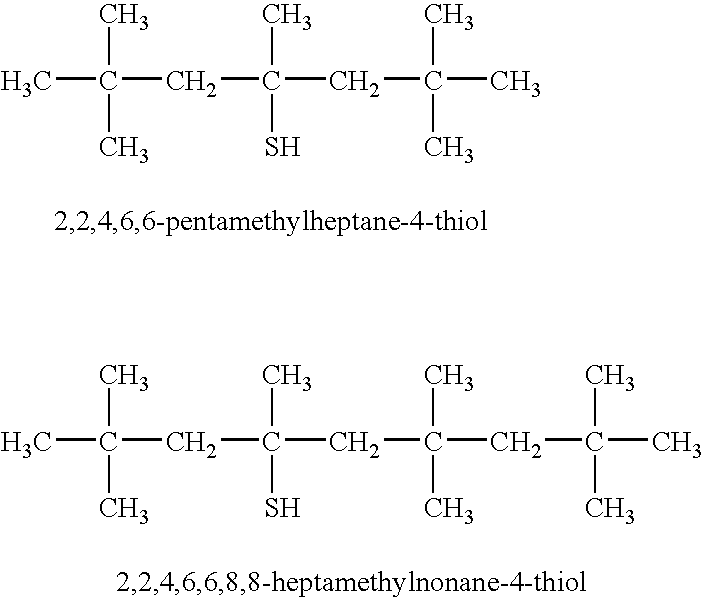Nitrile rubbers
a technology of nitrile rubber and nitrile salt, which is applied in the field of nitrile rubber, can solve the problems of high and therefore undesirable outlay, frequent problem of storage stability of such nitrile rubber, and poor vulcanization performance, and achieve good vulcanization performance, good storage stability, and good processing properties
- Summary
- Abstract
- Description
- Claims
- Application Information
AI Technical Summary
Benefits of technology
Problems solved by technology
Method used
Image
Examples
examples
[0188]I Production of the NBR Latices A, B, C
[0189]The NBR latices A, B and C used in example series 1) to 5) were produced according to the base formulation shown in Table 1, with all starting materials being reported in parts by weight per 100 parts by weight of the monomer mixture. Table I also indicates the respective polymerization conditions.
TABLE 1Latex No.ABCButadiene738156Acrylonitrile2712.5 / 6.544Total amount of water190180170Erkantol ® BXG1)3.693.693.69Baykanol ® PQ2)1.101.101.10K salt of coconut fatty acid0.730.730.73KOH0.050.050.05t-DDM3)0.24 / 0.240.27 / 0.15 / 0.060.5 / 0.2Potassium peroxodisulphate4)0.39 / 0.190.45 / 0.200.27Tris(α-hydroxyethyl)amine5)0.570.610.15Na dithionite6)1.201.201.20Potassium hydroxide1.281.281.28Vulkanox ® KB7)1.251.251.25Polymerization temperature [° C.]171820Polymerization conversion [%]757574.5Polymerization time [h]11157.51)Sodium salt of monosulphonated and disulphonated naphthalenesulphonic acids containing isobutylene oligomer radicals (Erkantol ® ...
examples 1-10
Examples According to the Invention and Comparative Examples
[0203]Storage stability of the nitrile rubber (28.9% by weight of acrylonitrile) which was obtained from latex A under the coagulation and washing conditions indicated in the table below.
[0204]Washing of the crumb was in all cases carried out at 20° C. using deionized water (DW).
[0205]The comparative examples are denoted by a “C” before the number.
Coagulation of the latexConc.Amountof theof saltsaltbasedpHsolutionon NBRWashingChlorineML(1 + 4of theType of[% by[% byTtimecontentCaMg@100° C.) [MU]Examplelatexsaltweight]weight][° C.][h][ppm][ppm][ppm]MV1MV2SS18.4CaCl20.66203.8110129035255328.4CaCl21.212203.5108124025356336.0 / CaCl21.212203.51001235250500HClC46.0 / MgCl21.616204.33325325439653H2SO4C58.4MgSO41.515203.53010350486719C66.0 / MgSO41.010202.52552604611165H2SO4C78.4Al2(SO4)30.151.5202.7292350164114C86.0 / Al2(SO4)30.101.0202.5282255>20>150H2SO4C98.4KAl(SO4)20.212.1202.5281124813789 C106.0 / KAl(SO4)20.151.5203.630415013585H2SO4...
examples 11-20
Examples According to the Invention and Comparative Examples
[0208]Storage stability of the nitrile rubber (28.9% by weight of acrylonitrile) obtained from latex A under the coagulation and washing conditions indicated in the following table.
[0209]Washing of the crumb was in all cases carried out at 20° C. using either deionized water (DW) or water containing calcium ions (BW)
Coagulation of the latexConc.Amountof theof saltWashingsaltbasedconditionsML1 + 4pHsolutionon NBRTypeChlorine@100° C.of theType of[% by[% byTofTimecontentCaMg[MU]Examplelatexsaltweight]weight][° C.]water[h][ppm][ppm][ppm]MV1MV2SS116.0 / NaCl / 770RTBW7.751108052548480H2SO4DW126.0 / NaCl / 770RTBW7.75858502748513H2SO4BW136.0 / MgCl20.88RTBW5.05175523047481HCl146.0 / MgCl2 / 0.87.6 / 0.4 RTBW5.0528901705146−5HClCaCl2156.0 / MgCl20.88RTBW55372522543452HClC166.0 / MgCl20.88RTDW53610225405919HCl176.0 / MgCl21.616RTBW58875026544462HClC186.0 / MgCl21.616RTDW5.03915255415817HCl199.5MgCl2 / 0.88 / 0.4RTBW5.04949010645483CaCl2209.5MgCl2 / 0.88 / 0.4RTB...
PUM
| Property | Measurement | Unit |
|---|---|---|
| glass transition temperature | aaaaa | aaaaa |
| glass transition temperature | aaaaa | aaaaa |
| glass transition temperature | aaaaa | aaaaa |
Abstract
Description
Claims
Application Information
 Login to View More
Login to View More - R&D
- Intellectual Property
- Life Sciences
- Materials
- Tech Scout
- Unparalleled Data Quality
- Higher Quality Content
- 60% Fewer Hallucinations
Browse by: Latest US Patents, China's latest patents, Technical Efficacy Thesaurus, Application Domain, Technology Topic, Popular Technical Reports.
© 2025 PatSnap. All rights reserved.Legal|Privacy policy|Modern Slavery Act Transparency Statement|Sitemap|About US| Contact US: help@patsnap.com

